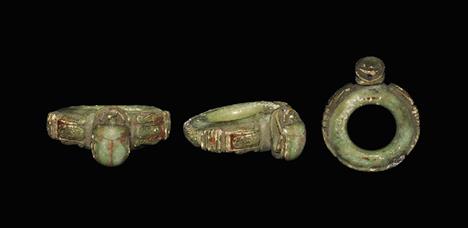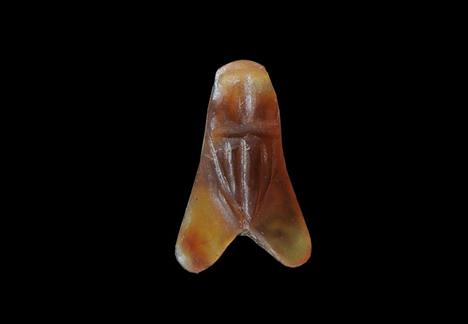An Oceanic fibre woven basket and cover, 14cm diameter containing a quantity cowrie and other shells, a hair fly whisk mounted on a parasol handle, 41cm long, a small kava bowl, a carved seed amulet with red cloth and a shell necklace. (a lot) Provenance: James Blyth (1834 - 1924) and thence by descent.
We found 4003 price guide item(s) matching your search
There are 4003 lots that match your search criteria. Subscribe now to get instant access to the full price guide service.
Click here to subscribe- List
- Grid
-
4003 item(s)/page
India, 19th-early 20th century AD. Cast bronze head of a tribal deity with horns and elongated hair style, around the neck are a number of necklaces and an amulet in the form of two tiger claws. 799 grams, 21.5cm (8 3/4"). From a large London collection; formed between 1980-late 1990s. Possibly a tribal version of the god Shiva. Made in Bastar region, central India. [No Reserve] Fine condition.
India, 19th-early 20th century AD. Cast bronze head of a horned tribal deity with elaborate hair style pulled up into a cone shape with lotus flower finial and two strands of hair falling down; the deity wears earrings and strings of necklaces with amulet. 701 grams, 19.5cm (7 3/4"). From a large London collection; formed between 1980-late 1990s. Possibly a rural form of the Hindu god Shiva. Made in the Bastar region of central India. [No Reserve] Fine condition.
India, 19th-early 20th century AD. Cast bronze head of a tribal deity, possibly Shiva, with tall conical headdress with horns to either side; rows of necklaces with prominent amulet representing two tiger claws. 1.7 kg, 27cm (10 1/2"). Acquired on the London art market in the late 1980s. Made in the Bastar region of central India. [No Reserve] Fine condition.
Egyptian Style Steatite Scarab Annular AmuletAn undated archaistic carved steatite hoop in Roman Period, 30 BC-323 AD style, with segmented panels to the outer edge, scarab to the bezel. 17 grams, 47 mm (1 3/4"). From an old Swiss collection; acquired on the London market in the 1980s. TimeLine Auctions Ltd arranges printed catalogue rostrum Auctions, eAuctions and Timed Auctions where we offer antiquities, ancient artefacts / artifacts, antiques, collectibles, coins, medals and books for public sale. [No Reserve]Fine condition.
Egyptian Style Glazed Composition `Sleeping Duck` Amulet GroupA mixed group of undated archaistic amuletic pendants, each formed as a duck with head resting on the spine, intaglio hieroglyphs to the underside. 22 grams total, 18-33 mm (3/4 - 1 1/4"). From an old Swiss collection; acquired Beirut before 1980. TimeLine Auctions Ltd arranges printed catalogue rostrum Auctions, eAuctions and Timed Auctions where we offer antiquities, ancient artefacts / artifacts, antiques, collectibles, coins, medals and books for public sale. [4, No Reserve]Fine condition.
Silver & Niello Fish Shape Amulet Pendant, Persia, Circa 1900. With niello floral and foliage ornaments inscribes SHADAI (one of God`s names) with five tussles each with a Hebrew letter making the Kabbalistic initials for the five angels: Uriel, Refal, Gavriel, Michael and Nuriel. Comes with a silver chain. This amulet was part of the collection of the late legendary mayor of Jerusalem Teddy Kollek. Fish length - 8cm / 3.15in. Chains length - 68cm / 26.77in. 60gr / 2oz.
Egyptian Large Glazed Composition Taweret AmuletLate Period, 664-332 BC. A pale blue amuletic pendant of the goddess Taweret in hippopotamus-headed form with rectangular base and feathered dorsal pillar; ribbed suspension loop. 10 grams, 57mm (2 1/4"). Ex Hubbard collection, London, UK; acquired on the UK art market from 1990. [No Reserve]Very fine condition.
Egyptian Glazed Composition Horus AmuletLate Period, 664-332 BC. A dark blue figurine of Horus in falcon-headed form on a rectangular base with dorsal pillar and crown. See Andrews, C. Amulets of Ancient Egypt, London, 1994. 2.26 grams, 37mm (1 1/2"). From an important London collection, acquired in the 1970s. Fine condition.
Egyptian Glazed Composition Hand Amulet PendantPtolemaic Period, 332-30 BC. A dark blue amuletic pendant of an arm and extended hand; with antique gold suspension loop. 1.27 grams, 25mm (1"). Ex Hubbard collection, London, UK; acquired on the UK art market from 1990. [No Reserve]Fine condition.
Egyptian Glazed Composition Amulet GroupAmarna Period, 1353-1336 BC. A mixed group of amuletic beads and pendants including fruit, rosettes, rectangular plaques and discoid beads. 44 grams total, 2-37mm (1/10 - 1 1/2"). From a private collection formed in the early part of the 20th century. [Approximately 270]Fine condition.
Egyptian Glazed Composition Amulet GroupLate Period, 664-332 BC. A mixed group of amulets, each with dorsal pillar, comprising: Shu kneeling with raised hands; Bastet seated on a throne; fragment of Sekhmet inscribed with offering formula on dorsal pillar; Horus with conical headdress; two female figures. 23 grams total, 18 - 41mm (3/4 - 1 1/2"). Ex Hubbard collection, London, UK; acquired on the UK art market from 1990. [6, No Reserve]Fine condition.
Egyptian Glazed Composition Amulet Necklace with Scarab of Rameses III20th Dynasty, 1189-1077 BC. A restrung necklace of mainly discoid beads with six small scarabs and one larger, eight wedjat amulets; one steatite scarab of Rameses III (1186-1155 BC); screw closure. 32 grams total, 60cm (23 1/2"). Ex Hubbard collection, London, UK; acquired on the UK art market from 1990. Usimare Ramesses III (also written Ramses and Rameses) was the second Pharaoh of the Twentieth Dynasty and is considered to be the last great New Kingdom king to wield any substantial authority over Egypt. He was the son of Setnakhte and Queen Tiy-Merenese, and was probably murdered by an assassin in a conspiracy led by one of his secondary wives and her minor son. [No Reserve]Fine condition.
Egyptian Carnelian Fly AmuletMiddle Kingdom, 2133-1797 BC. A carved amuletic pendant in the form of a fly, pierced for suspension. See Andrews, C. Amulets of Ancient Egypt, London, 1994, pp.62-3. 0.37 grams, 23mm (1"). From an important London collection, acquired in the 1970s. Fine condition.
Egyptian Glazed Composition Scarab of Pharaoh NebfaureHyksos Period, 17th-16th century BC. A white scarab amulet with double red crowns, inscribed to the underside with hieroglyphic text, possibly the name Nebfaure `the revered one`. 4.35 grams, 23mm (1"). Ex Wallace collection, Sydney, Australia; acquired before 1982. [No Reserve]Fine condition, some abrasion.
Egyptian Glazed Composition Scarab with Ankh, Nefer and WaterpotNew Kingdom, 1550-1070 BC. A pale blue scarab amulet with three hieroglyphs to the underside: ankh (life), nefer (beautiful) and a waterpot. 2.37 grams, 18mm (3/4"). Ex Wallace collection, Sydney, Australia; formerly with Dr. Bron Lipkin, London, UK; with a copy of a certificate of authenticity and guarantee from Dr. Lipkin. [No Reserve]Fine condition.
Near Eastern Stone Amulet Group2nd-1st millennium BC. A mixed group of hardstone amuletic pendants comprising: a leaf-shaped plaque; a ram; a sheep`s head; a horse; two axes; a domed plaque with four arms, drilled and pierced; a face with scaphoid eyes. 34 grams total, 13-26mm (1/2 - 1"). Property of a West London gentleman; acquired between 1980-2010. [8, No Reserve]Fine condition.
Egyptian Carnelian Poppy Amulet Gold Pendant GroupLate Period, 664-332 BC. A mixed group of carnelian poppy-head amulets comprising: one a globular bead with gold pin and gussetted stud; one a carved pendant with antique gold fittings and glazed composition tubular bead; one similar with two tubular beads. 4.57 grams, 12-51mm (1/2 - 2"). Ex Hubbard collection, London, UK; acquired on the UK art market from 1990. [3, No Reserve]Fine condition.
Egyptian Gold Amulet Pendant GroupLate Period, 664-332 BC. A group of two amuletic pendants comprising: a green glazed composition and a carnelian profile of Anubis each mounted in a antique gold pendant. 5.26 grams total, 21-26mm (3/4 - 1"). Ex Hubbard collection, London, UK; acquired on the UK art market from 1990. Anubis is the name of a jackal-headed god associated with mummification and the afterlife in ancient Egyptian religion. [2, No Reserve]Very fine condition.
Egyptian Ceramic Mould GroupNew Kingdom, 1550-1070 BC and Late Period, 664-332 BC. A group of terracotta moulds comprising: one globular for modelling the base of a scarab, Ramesside period (New Kingdom); one flat for modelling a wedjat amulet (Late Period). 16 grams total, 16-35mm (3/4 - 1 1/2"). Ex Hubbard collection, London, UK; acquired on the UK art market from 1990. [2, No Reserve]Fine condition.
Egyptian Dr. Collings`s Collection Diary, Photographs and Artefact CollectionDiary dated 1897 AD. A mixed group of items once the property of Dr. D.W. Collings comprising: a manuscript diary in unbound paper quires with pen and pencil annotations, sketch maps and sketches describing the doctor`s travels in Egypt; a card envelope containing a portion of fabric, marked `Egypt ancient. Fragment of coarse woven material (flax?) used as a backing of a mummy cartonnage? Ptolemaic period`; a rectangle of twill woven cloth in an envelope; a glazed composition pendant on card; two hieroglyphic seal impressions on card; a stone spindle whorl; a glazed composition figure of Thoth on a wooden base; a hardstone heart amulet; a restrung necklace of tubular and discoid glazed composition beads; a group of fourteen photographs taken by Dr. Collings with a frame camera, mainly scenes of the Nile. 537 grams total, diary pages: 23 x 17cm (9 x 6 3/4"). Ex Dr. Dudley Collings collection, Suffolk, UK, thence by descent; acquired by Collings in 1897 while on his travels in Egypt. Dr Dudley Willis Collings (1870-1955) was the first curator of the Southwold Museum and the town`s doctor. Collings`s son and daughter-in-law were close friends of Eric Blair (George Orwell) who shared their interest in anthropology. The F.G. Hilton Price collection was published in London in 1897 in a dedicated illustrated volume entitled A Catalogue of the Egyptian Antiquities in the Possession of F.G. Hilton Price. [24]Fine condition.
-
4003 item(s)/page



























































